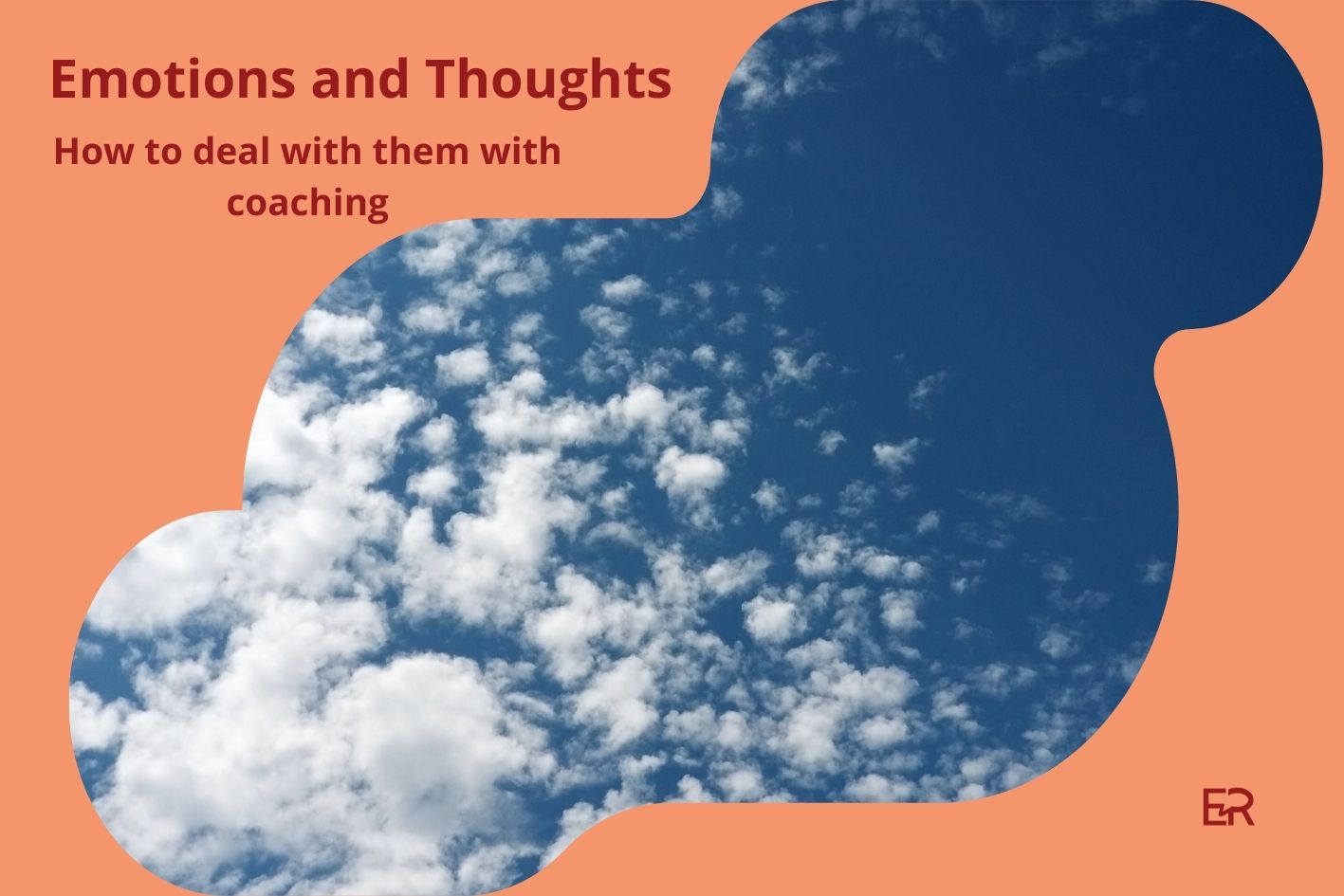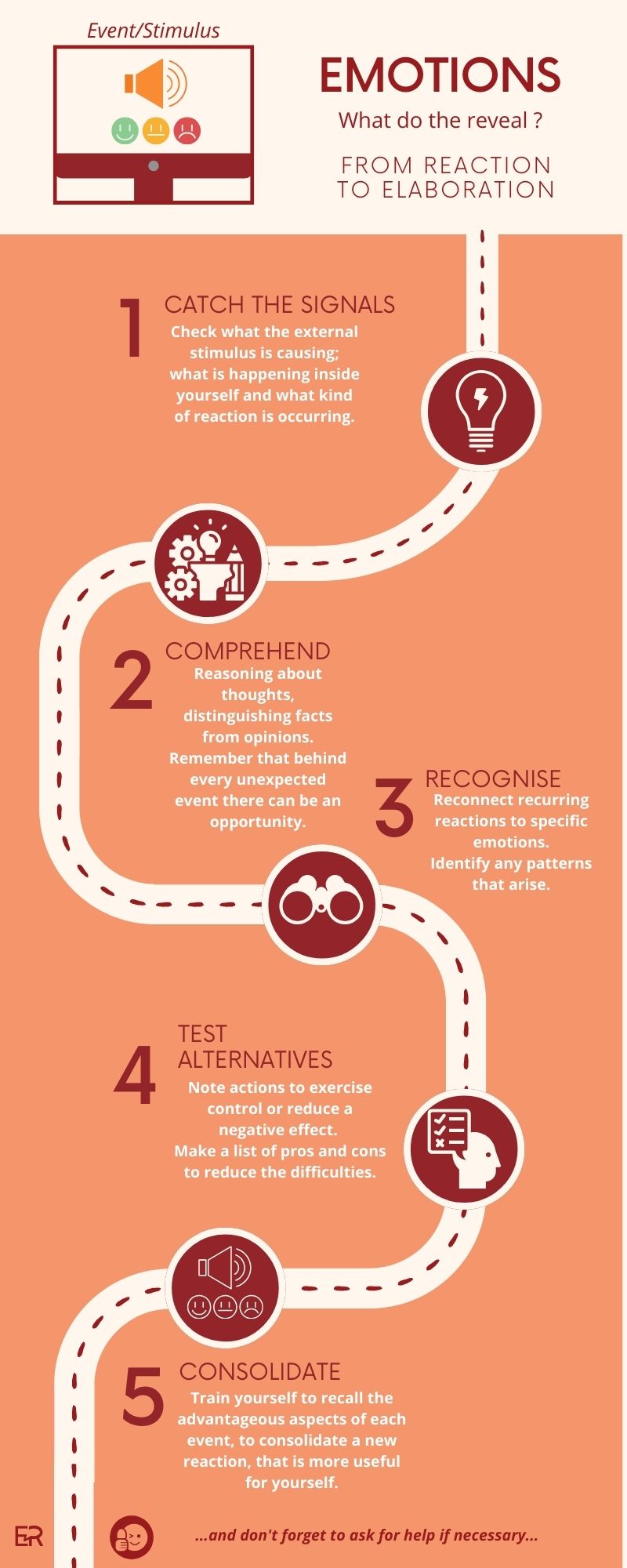
1 April 2024 Emotions and thoughts how to deal with them with coaching
How to deal with emotions and thoughts with coaching
Emotions and thoughts are two intrinsically linked elements of our human experience and with coaching it is possible to deal with them so as not to be overwhelmed by those that cause sorrow and suffering.
Emotions and thoughts mutually influence how we live and relate to the world, so it is important to learn how to recognise, understand and deal with them.

Emotions: types and interactions with thoughts
Emotions, simplifying, can be classified into two main categories:
- those that make us feel good, such as joy, gratitude, trust, and serenity;
- those that cause us sorrow and suffering, such as sadness, anger, fear, and anxiety.
Both types of emotion play an important role:
the first can increase our creativity and performance;
the latter, instead, can help protect us from dangers and threats but also motivate us to change or improve our situation.
Coaching is useful to process emotions that cause us to regret and that we would like to avoid, but which are not the source of deep, chronic, and recurring discomfort, dictated by past traumas that impede the performance of one's professional or daily life activities, because in that case it is advisable to turn to psychotherapy.
Essentially, emotions that provoke displeasure are impulses to act that evolution has endowed us with to deal with life's emergencies in real-time, to prepare and adapt. However, in our normal day-to-day interactions, perceived emergency signals do not always mean facing imminent danger in concrete reality.
From a physiological point of view, an emotion usually arises before the person is aware of it and manifests itself in reaction to an event, with different physiological signals, degrees, and intensities of emotional states.
Some physiological signals preceding an emotion can be arousal, body heat, variation of breathing, non-verbal facial and voice signals, etc.
Emotions and thoughts: from reaction to processing

If it is true that one cannot choose the moment and which emotions to feel for a given event, it is also true that one can choose how to think and how to react.
When the physiological signals anticipating emotion occur, one can learn to 'recalibrate' and counterbalance the impulse reaction through reasoning.
This allows more constructive considerations and thoughts to be initiated, resulting in more beneficial action plans and behaviour.
But how to do all this?
It is possible with the help of a coach that in the coaching process accompanies through the different steps to recognise, understand, and manage personal emotions and the signals that anticipate them.
Recognising emotions and thoughts: the different states of fear
The first step in tackling emotions and thoughts in a healthy way is recognising them. When faced with an emotion, a useful thing to do is describing it correctly and in a balanced way, without exaggerating it but also without belittling or ignoring it.
An emotion can manifest itself in different emotional states, from the least to the most intense. Those of an emotion such as fear, for example, take the following form:
(- - - ) Apprehension (anticipation of probable danger)
| Trepidation/tension
| Anxiety
| Fear (anticipation of grave danger)
| Despair (feeling of inability to reduce a danger)
| Panic (a phase resulting from despair)
| Horror (a mix of fear and disgust)
(+ + +) Terror (the most intense fear)
When trying to describe how one feels, saying "I am apprehensive", "I am anxious' or "I am terrified of" is not the same thing, therefore it is important to learn to recognise and describe precisely what one is feeling, with greater sensitivity and attention to the different physiological signals.
Correctly defining the emotion one is experiencing, as well as 'allowing' oneself to listen to it in its nuances, can help overcome the emotion's intensity.
Training ourselves to listen to emotion when it causes us sorrow and tension is a practice we can learn to do in our daily lives.
Whenever one perceives a change in energy that needs to be released (= physiological signal) or tension in one's body that anticipates fear, one must make the effort to recall words that convey positive feelings and draw on these, together with one's breath, to release such tensions.
Such words are for example 'calm' and 'courage' or 'attention' and 'curiosity'. Diverting attention through thought helps to release and bring out energy and, once calmness has been restored, to find alternatives to experience more useful and positive feelings.
Describing and understanding own emotions and thoughts
Neuroscience has shown that the emotions tread paths in the brain that have already been traced in the past and imprinted in the memory. The brain is incapable of questioning its thoughts because it loves and tends to reconfirm what it already knows and has already experienced.
It often happens that emotional memory recurs in the present with the same reactions as in the past and, when evaluation is quick and automatic, it can happen not to realise that things may be different and not pose the same threat as in the past.
In reality, each situation is a case in point and there are different solutions in each renewed context.
Questioning emotion the moment it presents itself means recognising it at the moment one is experiencing it, understanding what kind of message it is sending, and then identifying the best strategy to deal with it.
Once the understanding and awareness of personal emotionsis reached one can practice controlling one's interpretation of things, in a positive way and to personal advantage.
Thoughts and emotions in changing coaching perspectives
To deal with emotions and thoughts constructively, once an understanding of how they develop is reached, strategies for managing them effectively can be identified with coaching.
This is done by shifting the focus from the area of seemingly dead-end difficulty to the area of the possibility of greater control and scope for action in the present and future.
One of the main characteristics of coaching is to focus on improvement in the present to proceed with what has been learned in the future.
Usually in a coaching session, you can initiate reasoning on the modality with which some thoughts are starting.
Thus it is possible, on the one hand to address those that are limiting or dictated by prejudice that do not help to overcome difficulties and on the other hand to facilitate those functional to initiate more useful and constructive actions.
The exploration of emotions and the signs by which these manifest themselves are an important part of a Coaching program.
In the case of emotions that cause sorrow and suffering, it is a matter of taking note of how they manifest themselves to seek solutions without indulging in unproductive thoughts .
Externally posed coaching questions can return and elicit different logical meanings of the reasoning and thus stimulate alternative answers. What makes the process effective is the reflection from the coach and the subsequent reasoning.
The coaching approach brings out insights that lead to change in the conversation and thus arrive at new, different solutions.

A popular maxim states
"the clouds of emotions are fleeting, but the sky of life is always blue'.
The sky of life is always blue, even if the clouds of the emotions they can black it out for a while.
Different emotions, even the unpleasant and uncomfortable ones, are transitory. They come and they go, but in this one can try to take a proactive and reasoned attitude.
Conclusion: How Coaching deals with emotions and thoughts
Coaching, between past and future experiences, helps to bring attention back to the present, interrupt the flow of automatic thoughts, and get back in touch with the here and now.
Through the responses that emerge in the dialogue regarding the emotions and the reflection from the coach, like a mirror, takes place the useful change of perspective to bring the moment's mood back into balance.
Training the ability to identify one's own and others' emotions, and making conscious use of individual ones, is important.
This puts us in a position to choosing how to react and how to think without being carried away by automatic reactions in response to events.
Furthermore, since the emotions are contagious, it is good to be aware that they can both facilitate relationships with other people and also influence them negatively. This is therefore an additional reason to learn to recognise, understand and manage personal emotions.
Do you want to try to question your emotions with my help?
Read also my article on awareness
Self-awareness: what it is, how it develops and how it can help achieve well-being
FURTHER RESOURCES ON EMOTIONS
Read the article (in Italian) by Mindful Coach Hélène Chaperon
Think positive! But not too much...
Watch the video of Susan David
